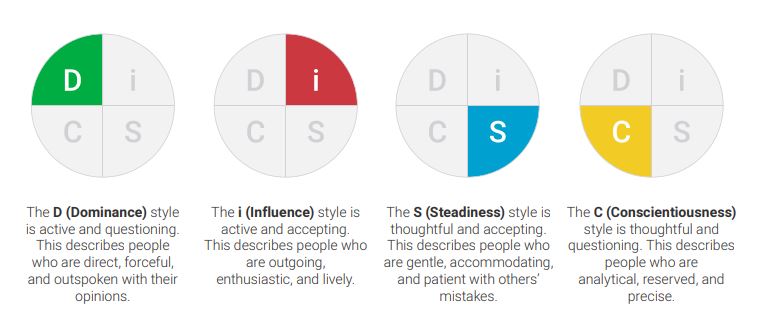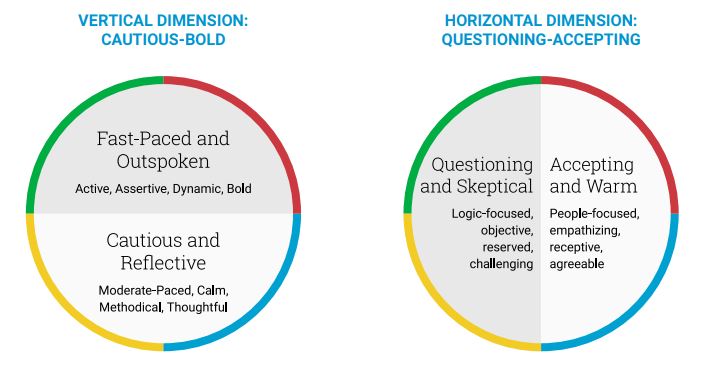
Everything DiSC® is a personal development learning experience that measures an individual’s preferences and tendencies based on the DiSC® model. But, what is the DiSC model?
The DiSC Model is a simple yet powerful model that describes four basic behavioral styles: D, i, S, and C.
- D: Dominance
- i: Influence
- S: Steadiness
- C: Conscientiousness
Everyone is a blend of all four DiSC styles—usually one, two, or even three styles stand out. Each person has a unique behavioral profile with different styles and priorities—no one style better or worse than the next. These differences in style can be extremely valuable. Once you assess these differences and harness their value, better workplace communication AND healthier organizations become possible.

Two Dimensions of Human Behavior
Although DiSC describes four styles, the model is, at its core, two-dimensional. These two dimensions reflect fundamental aspects of human nature and can be viewed as independent constructs.

DiSC Vertical Dimension
The vertical dimension is best described as level of activity, ranging from active to thoughtful.
People with DiSC styles at the top of the circle tend to be fast-paced and are often described as assertive, dynamic, and bold. Traditional explanations of the model suggest that these people perceive themselves as more powerful than the environment. Because of this perception, they tend to exert effort to change their circumstances.
Conversely, people with styles that fall toward the bottom of the circle tend to be more moderate paced and are often described as calm, methodical, and careful. Traditionally, these people are thought to perceive themselves as less powerful than the environment, and thus they are more inclined to adapt to existing circumstances.
DiSC Horizontal Dimension
The horizontal dimension runs from questioning to accepting.
People with DiSC styles that fall toward the left side of the circle are naturally more skeptical in nature and are often described as logic-focused, objective, and challenging. A traditional explanation of these characteristics is that these people see the environment as antagonistic. In other words, they instinctively withhold trust from people and ideas until those outside elements can be thoroughly vetted.
On the other hand, people with styles on the right side of the circle are naturally more receptive in nature and are often described as people-focused, empathizing, and agreeable. Traditionally, they are said to see the environment as being aligned with their interests. In essence, they are biased to see the people and ideas around them as favorable and are thus inclined to trust them.
Why Everything DiSC is Better
As technology has evolved, DiSC has too. Everything DiSC online assessments use the most advanced assessment method (adaptive testing) and sophisticated algorithms to quickly analyze a person’s responses and deliver the most precise feedback possible. The profile translates these assessment results into a personalized narrative that’s both actionable and memorable. All Everything DiSC assessments are application-focused, so the feedback is presented to you as a leader, manager, individual contributor, or sales person.
Validation
Psychological instruments are used to measure abstract qualities that we can’t touch or see. These are characteristics like intelligence, extroversion, or honesty. So how do researchers evaluate these instruments? How do we know whether such tools are actually providing accurate information about these characteristics or just generating haphazard feedback that sounds believable? Simply put, if an instrument is indeed useful and accurate, it should meet a variety of different standards that have been established by the scientific community. Validation is the process through which researchers assess the quality of a psychological instrument by testing the tool against these different standards.
Validation asks two fundamental questions:
How reliable is the tool? That is, researchers ask if an instrument measures in a consistent and dependable way. If the results contain a lot of random variation, it is deemed less reliable.
How valid is the tool? That is, researchers ask if an instrument measures accurately. The more that a tool measures what it proposes to measure, the more valid the tool is.
To see how accurate Everything DiSC is read Everything DiSC Theory and Research.
